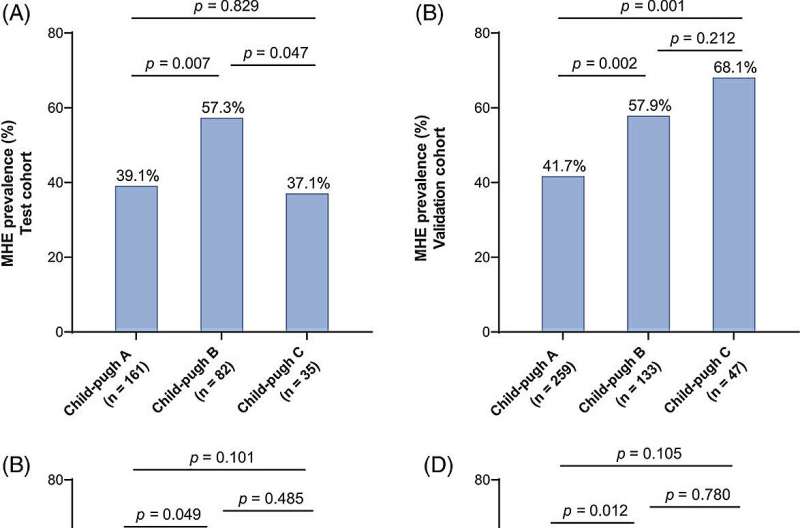This article has been reviewed according to Science X's editorial process and policies. Editors have highlighted the following attributes while ensuring the content's credibility:
fact-checked
proofread
Detection of minimal hepatic encephalopathy in patients with cirrhosis based on the Stroop-CN model

A paper published in MedComm presented a Chinese EncephalApp diagnosis model (Stroop-CN) based on healthy controls distributed throughout the country and covering different demographic information.
The Stroop-CN model was used for independent diagnosis of minimal hepatic encephalopathy (MHE) and found a prevalence of up to 46.7% in patients with cirrhosis and even higher in those with worse disease conditions. Meanwhile, the EQ-5D score revealed that MHE was associated with a significant decline in quality of life.
This study is led by Dr. Xiaolong Qi (Center of Portal Hypertension, Department of Radiology, Zhongda Hospital, Medical School, Southeast University, Nurturing Center of Jiangsu Province for State Laboratory of AI Imaging & Interventional Radiology) and Dr. Junliang Fu (Senior Department of Infectious Diseases, the Fifth Medical Center of Chinese PLA General Hospital, National Clinical Research Center for Infectious Diseases).
Based on a nationwide, multicenter study, the team presented a diagnosis model named Stroop-CN. Through their model, minimal hepatic encephalopathy (MHE) could be confirmed in 10 min.
"The initial aim is how could we help patients before it is too late," says Dr. Fu. As one of the crucial comorbidities, hepatic encephalopathy occurs in 50–80% of cirrhotic patients and leads to high mortality. Therefore, MHE, the early phase of hepatic encephalopathy, characterized by neuropsychological disorders without behavioral abnormalities, plays an essential role in early intervention.
While studies have demonstrated that MHE significantly reduces patient survival and can be reversed, the insidious nature of the disease and the complexity of traditional pen-and-paper experiments continue to straddle both patients and physicians.
The group tried various diagnostic tools, with the Stroop test attracting their attention because of its user-friendliness. However, the team immediately realized that individual information such as age and education can lead to changes in diagnostic thresholds. So, the next question they faced was, how to use this software for rapid MHE diagnosis?
In this study, they chose to synchronize the results of a large-scale collection of healthy controls to create the "Stroop-CN" model. Based on this model, information such as the age of the subjects was submitted to help determine whether the patient's cognitive level was lower than that of their healthy counterparts. On the other hand, the corresponding time, financial, and workload burdens must also be considered.
"Time and speed are also important. We have to take it into consideration, especially in China, where one of the fifth patients got a liver problem," says Dr. Qi. Using the Stroop-CN model, their slowest-operating MHE patients completed the tests in less than 5 min.
One of the reasons that medicine still does not pay enough attention to MHE is the complexity of the diagnosis. This paper uses a simple Stroop test to build a diagnostic model that can be applied even to subjects who can only identify colors and a few words.
Further, MHE was found in nearly half of the patients with cirrhosis accompanied by reduced QOL. This evidence would apply to cirrhotic patients in China and, to some extent, provide a reference for exploring a generally applicable diagnostic and monitoring method for MHE.
More information: Xiaoyan Li et al, Detection of minimal hepatic encephalopathy in patients with cirrhosis based on the Stroop‐CN model (NCRCID‐CHESS 2106): a prospective multicenter study, MedComm (2024). DOI: 10.1002/mco2.627



















